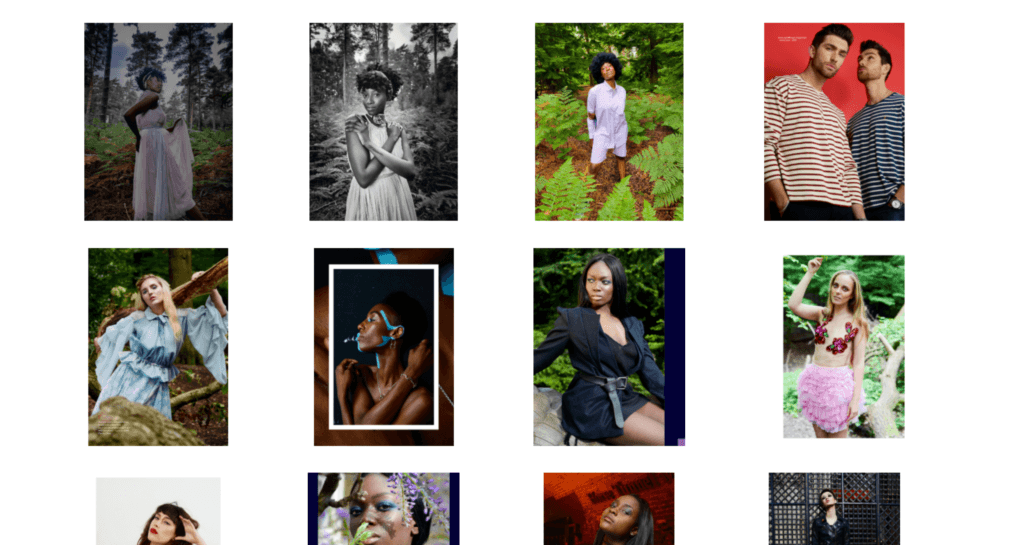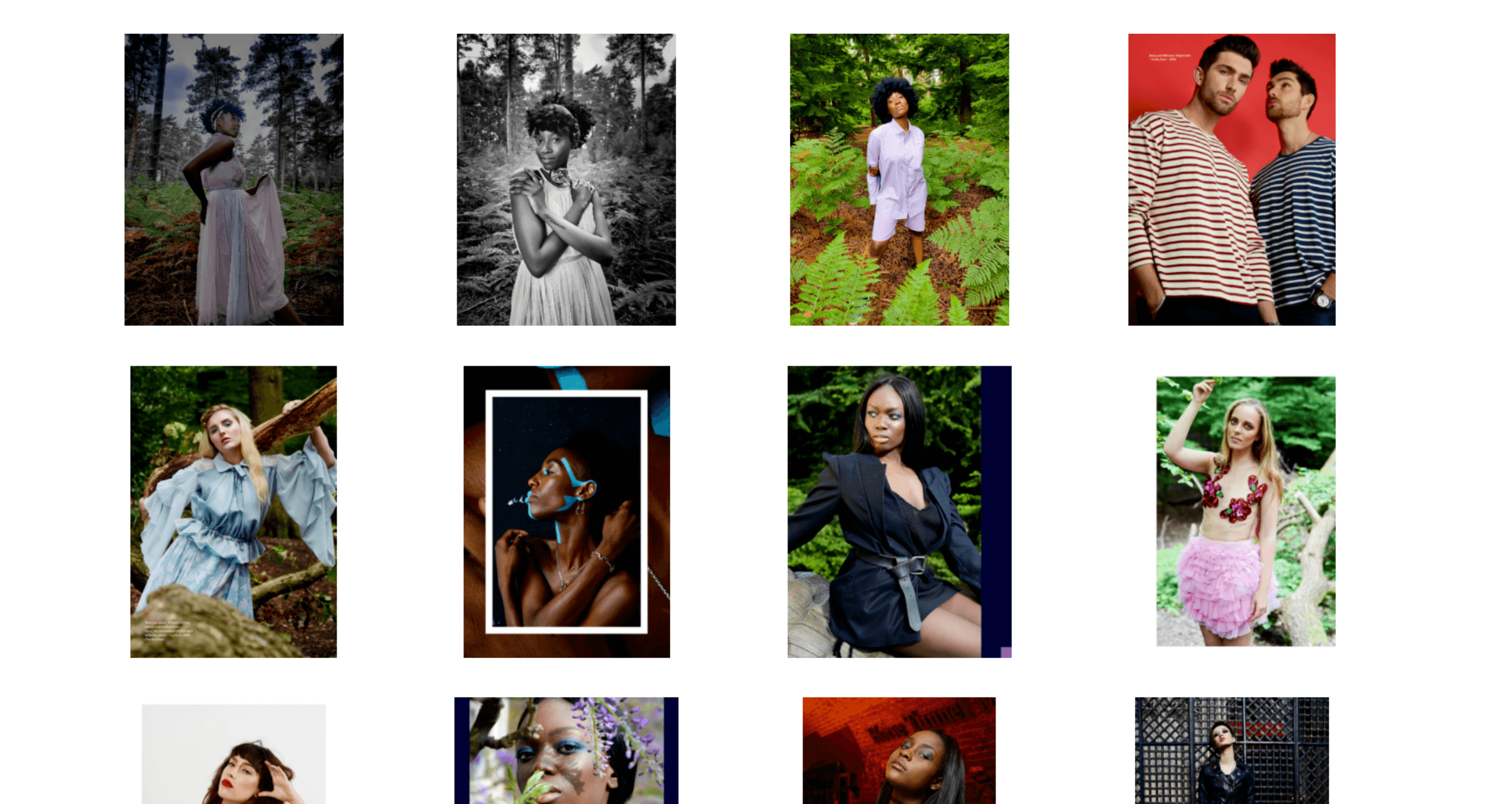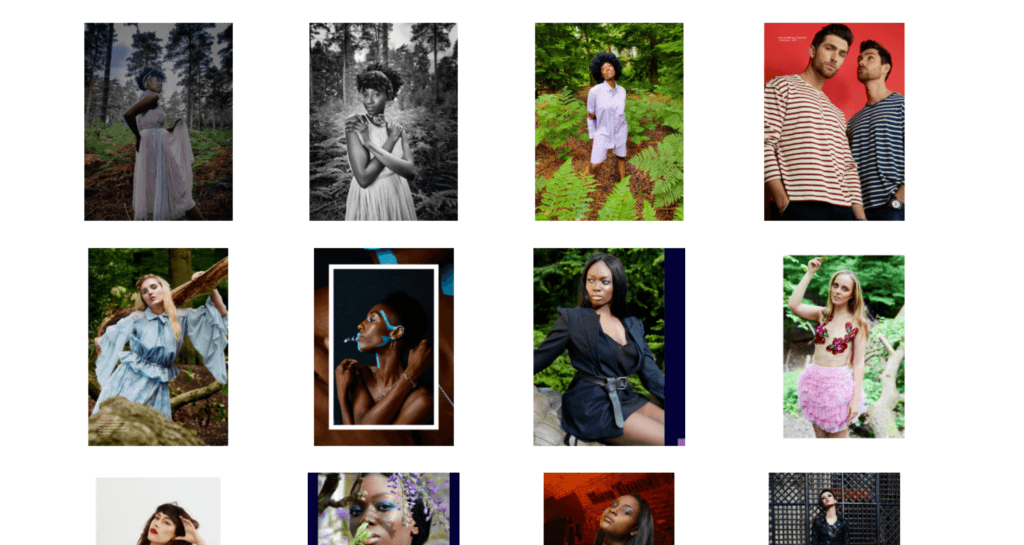A good portfolio can be the difference between getting hired and not. It’s how brands choose whether to work with you. Even if you’re not looking to work as a full-time professional photographer, it’s also how models, designers, makeup artists, and any other team members will decide whether to work with you.
This means that having a great portfolio is extremely important. In fact, you don’t just want it to be great – you want it to be awesome and blow anyone who sees it away. Here’s how to get that reaction, with ten actionable steps that will get you there!
Here is what we will cover:
- Shoot with purpose
- Have a vision in mind
- Hire a good team
- Use a professional retoucher
- Choose only the best
- Cut down the numbers
- Make client-first selections
- Display format matters
- Update, refresh, and review
- Take work thoughtfully
Recommended Reading: Want to learn how to make your photos stand out from everyone else’s? Grab a copy of Photzy’s Effective Storytelling premium guide.
Shoot With Purpose
The first thing that you need to do is to know your purpose in every shoot. Why are you taking these pictures? Are they going to look good in your portfolio?

Whether you draw inspiration from other photographers, specific tones, editing techniques, or anything else, keep them strong in mind as you create your portfolio. Photograph by Uby Yanes
If they won’t and if you’re being paid, you might want to charge the client more to ensure you still benefit. If you’re not being paid, why are you doing the photoshoot at all?
If you always make sure you have a purpose when you shoot, then you’ll have a better collection of images to draw your portfolio from in the first place.
Have a Vision in Mind
It’s also important to create a vision. The work in your portfolio will lead to you getting hired for more of the same, so you shouldn’t include images that you wouldn’t want to recreate.
Decide on the type of photography you want to create and develop a style if you don’t already have one. Then, you should always keep that vision in mind when you’re shooting for your portfolio. This will help to create a coherent and strong body of work that clearly shows the kind of work you can – and want to – do.
Mood boards will help with this. Create a cheat sheet of the kind of images you’d like to create and go from there in terms of making them happen.
Key Lesson: Knowing what kind of photography you want to be hired for will allow you to shoot with purpose. Ask yourself how this shoot will stand up alongside your portfolio, and if it won’t fit, consider changing the shoot if you can.
Hire a Good Team

Who you work with makes a big difference! Photograph by Cody Lannom
Yes, I said hire! If you’re creating shoots particularly for your portfolio, why wouldn’t you want to work with the best? TFP (time for print – AKA free) shoots are all well and good, but if you want to work with experienced models, high-quality makeup artists, and respectable designers, most often you will have to spend a bit of cash.
The work in your portfolio will lead to you getting hired for more of the same, so you shouldn’t include images that you wouldn’t want to recreate.
Think of this as an investment in your future. A great portfolio will get you hired. A shoddy portfolio put together the best you can without spending any money will almost certainly not be as effective.
Use a Professional Retoucher
Unless you already work as a professional photo retouch artist, chances are that you will not be able to do the work to the standard of an advertising campaign or magazine editorial. Therefore, it’s a good idea to ask someone who is at that standard to touch up your images.
Remember, your goal is to show the people who might hire you what they will get for their money. If they think your work won’t be up to scratch or will look unfinished, they’re not going to buy.
Key Lesson: An initial investment into your portfolio will take you a long way. You already shelled out for expensive camera equipment, so do you want to miss out on jobs or earn less because your portfolio isn’t up to scratch? Put out the extra money now and you’ll be able to reap the rewards.
Choose Only the Best
When you’re choosing which images to put into your portfolio, make sure that you choose only the best. There’s a saying: a portfolio is only as good as its weakest image. Take out those weak spots and make sure that you include only the very best images.


Both of these shots are stunning, but are they both needed when you have limited space and attention? Photographs by Dom Aguiar
It can be hard to make this decision yourself – after all, your images are your darlings. Ask for peer review from someone in the same field as you, or even a professional in the industry you’re looking to be hired in, and see what they think. Be merciless and cut, cut, cut.
Cut Down the Numbers
If your portfolio is fifty images long, you’re in trouble. Cut it down and cut it fast. Twenty images should be considered an upper limit. Really, a selection of ten really amazing images should do the job just as well.
Twenty images should be considered an upper limit. Really, a selection of ten really amazing images should do the job just as well.
For every image you introduce, there’s a higher chance that one of those images will be the weakest link. Ten absolutely killer images will be far more effective than fifty that are just great. When you don’t know what to cut, take out the oldest image to show that your work is present and current.
Key Lesson: Too many cooks spoil the broth, and too many images in a portfolio will drown out your best shots. Be brutal about your choices. Forget about your personal favorite stories or sets and look at the images with an objective view on quality.
Make Client-First Selections
You can create a new portfolio for every client you pitch to.
Isn’t that a lot of work, I hear you ask? Yes, but it also shows that you understand their style and needs. Ten minutes of research into the company’s past imagery will help you understand what to include. This is also great for photographers who work in a couple of different areas: the food photography client doesn’t need to see your animal portrait shots.

Paper portfolio, or tablet presentation? Let the client be the deciding factor. Photograph by Roberto Nickson
Display Format Matters
How you display your portfolio is really important and should also consider the client. Old-school corporate businesses will appreciate a leatherbound printed portfolio, and tech startups will absolutely want to see a link to an online gallery. Presentation really matters, so make sure that your images are clean, presented without distraction, and big enough to admire no matter the format.
Key Lesson: Create a portfolio that is customized to every client in format, image choices, and presentation style. You will soon find your rate of success to improve.
Update, Refresh, and Review
Now you have a finished portfolio, what next?
Well, a portfolio is never really finished. Make sure that you review your portfolio regularly, such as every month or so if you are shooting regularly, and every year even if you’re a hobbyist. Add new images, take out old ones, and always try to stay sharp and objective. If you no longer love an image, take it out.

Never stop thinking about your portfolio. Photograph by Logan Weaver
Take Work Thoughtfully
When taking new work, your first instinct may be towards whatever pays. But over time, you can be more selective with your projects. Start to work only on the photoshoots that will fit your work and style exactly, and that you would be pleased to include in your portfolio. This will actually allow you to charge more for your work since you’ll always be working at your personal highest possible standard!
Key Lesson: A portfolio is never finished. It grows and develops with you as a photographer. You may even find yourself pivoting to a new style – and that’s fine! Just make sure your portfolio reflects it.

Photograph by Rhiannon D’Averc
Recommended Reading: Want to learn how to make your photos stand out from everyone else’s? Grab a copy of Photzy’s Effective Storytelling premium guide.
Conclusion
If you want an awesome portfolio, the way to do it is clear:
- Know the direction of work you want to go in
- Hire a shooting team and photo retouching artist to make your initial portfolio work
- Narrow down your selection to a handful of only your very best shots
- Present your images in a unique gallery or printed selection for every client
- Review your portfolio constantly and always keep it fresh and of high quality by shooting the right jobs
Self-Check Quiz:
- How can you get your first shots for your new portfolio?
- Why is it a better idea to pay for shoots at first than to save money?
- How many images should you include in your portfolio?
- Which images should make the final cut?
- How should you display your portfolio?
- How many variations of your portfolio should you create?
- When is your portfolio done?
- How can you raise your rates by using your portfolio as a point of focus?
Learning Assignment:
Take a look at your existing portfolio, or your body of work if you’ve never arranged it into a portfolio. Using the tips in this guide, create a new portfolio that you feel reflects your desired work style and holds only the very best images. Is it a little on the light side? No problem – start creating a mood board now and set up your first focused portfolio shoot!














